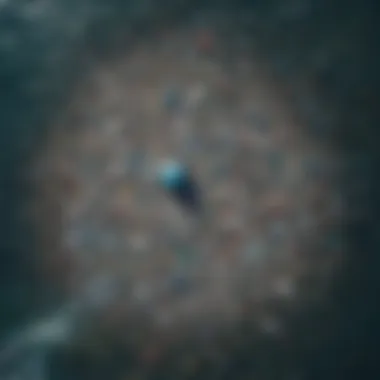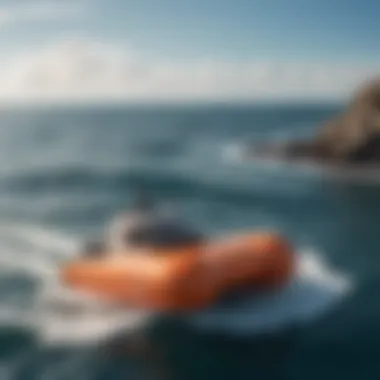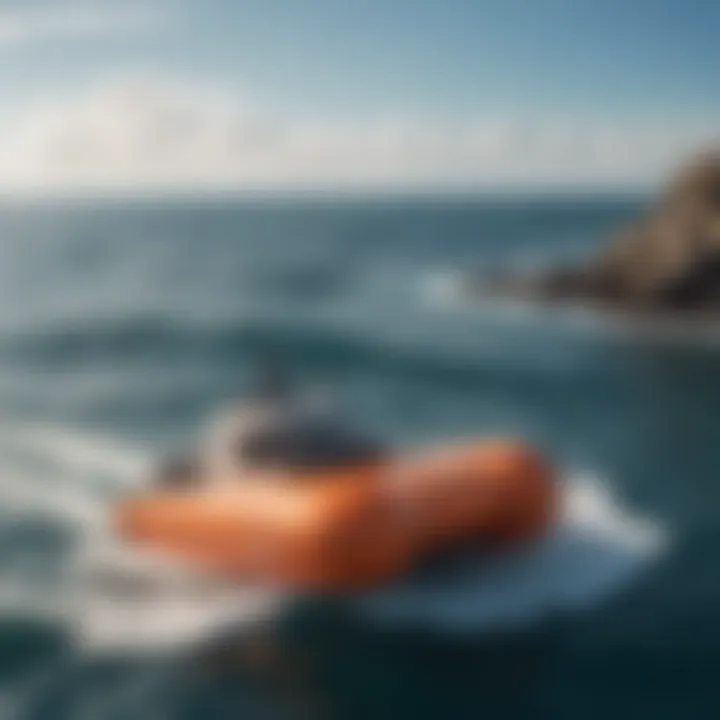Exploring the Ocean Clean-Up Project's Impact


Intro
The world's oceans, vast and mysterious, harbor not only creatures of unimaginable beauty but also an alarming amount of plastic waste. This issue poses a significant threat to marine life and the ecosystems that depend on healthy oceans. The Ocean Clean-Up project strives to tackle this colossal problem head-on. Established with a vision to rid the oceans of plastic debris, it employs innovative techniques and cutting-edge technology.
In this article, we will delve into the history, methodologies, challenges, and successes of the Ocean Clean-Up project. We shall explore how this initiative not only aims to clean the seas but also raises awareness about the environmental crisis we face. As we dissect the many facets of this endeavor, the aim is to present a thorough understanding of its relevance and impact on marine sustainability.
Gear Essentials
The Ocean Clean-Up initiative demands a specialized suite of gear and technology to efficiently retrieve plastic waste from the ocean. Here’s a closer look at what powers this ambitious project.
Equipment for Ocean Clean-Up
- Interceptor Vessels - These are specially designed boats that work in rivers, gently removing garbage before it can flow into the ocean. They are equipped with barriers to catch plastic.
- System 001 and 002 - These floating networks use ocean currents to concentrate debris. Once plastic is collected, it is transported to shore for recycling.
- Sensors and Drones - Innovative tech helps to map and monitor plastic pollution on a large scale, ensuring the team can identify high-impact areas.
- Deployment Instruments - These include anchors and buoys that assist in placing systems accurately within the ocean currents, maximizing capture potential.
Maintenance and Care Tips for Gear
To ensure the longevity and efficiency of the gear used in the Ocean Clean-Up project, specific maintenance protocols are essential:
- Regular Inspections - Inspect vessels and equipment for wear and tear regularly. This helps to identify any issues before they escalate.
- Cleaning Procedures - After deployment, the gear should be thoroughly cleaned to remove residue and prevent rust or damage from saltwater.
- Repairs - Any damages should be promptly repaired. This can save costs in the long run and maintain operational effectiveness.
Importance of Specialized Gear
The effectiveness of the Ocean Clean-Up project hinges on the advanced technology and equipment used. Each piece of gear plays a critical role in collecting plastic waste. The ability to operate in various oceanic conditions requires planning and skill, ensuring that the team is always prepared for the unpredictable marine environment.
Prelude to Marine Pollution
Marine pollution is a pressing issue that extends beyond just industrial waste or litter. It’s a complex situation that impacts ecosystems, human health, and local economies, especially for communities relying on the ocean for their livelihood. Understanding marine pollution sets the stage for recognizing initiatives like the Ocean Clean-Up Project, which seeks to address one of the most significant threats to our oceans today.
Marine pollution comes in various forms: plastics, chemicals, and even noise. Each has its consequences on sea life, such as entanglement, ingestion, and habitat degradation. For surfers and those in the water sports community, awareness of these pollutants is crucial. Not only do they impact the health of the ocean, but they also affect the quality of the waves and the overall experience of being in and around water.
Focusing on marine pollution allows us to grasp its scope and implications. By understanding what causes marine pollution, we can appreciate the efforts made to combat it. Moreover, the awareness cultivated around this topic can bring together surfers, paddleboarders, kitesurfers, and other water enthusiasts to advocate for healthier oceans. A collective understanding is the first step toward action, underscoring the importance of education and proactive measures.
"The ocean is not a vacuum; it is a vibrant ecosystem that reflects our activities ashore. We must protect it to preserve our way of life."
Defining Marine Pollution
Defining marine pollution is more than just identifying the contaminants present in our oceans. It encompasses the sources, types, and effects of these pollutants. At its core, marine pollution results from human actions, where waste products, whether intentional or accidental, are introduced into the marine environment.
For instance, plastic waste barely decomposes and often find its way into the ocean, where it creates hazardous conditions for marine life. Here’s a look at some common types:
- Plastics: Bottles, bags, and microplastics that break down but don't disappear.
- Chemicals: Pesticides, fertilizers, and oil spills that disrupt marine ecosystems.
- Marine Debris: Any solid material specifically left in the ocean which can choke sea creatures.
Knowing these definitions and categories provides clarity on why initiatives like the Ocean Clean-Up Project are vital and necessary.
Scope and Scale of the Issue
The scope and scale of marine pollution are staggering—it's an issue that transcends geographical boundaries. Some estimates indicate that tens of millions of tons of plastic enter the ocean each year. The Great Pacific Garbage Patch alone is a massive accumulation of this pollution, symbolizing the severity of the problem.
The following points underscore the enormity of marine pollution:
- Global Impact: Marine pollution does not just affect coastal areas; it reaches far inland, impacting ecosystems away from the shore.
- Biodiversity Loss: A significant number of marine species are endangered due to polluted habitats.
- Economic Consequences: Fisheries and tourism are heavily affected by poor marine health, influencing job security and economic stability.
In essence, the sheer volume of marine pollution is a clarion call for collective action. The more we understand the depth of the problem, the more equipped we are to participate in solutions, rallying fellow surfers, paddleboarders, and kitesurfers along the way.
Overview of the Ocean Clean-Up Initiative
The Ocean Clean-Up initiative represents a beacon of hope in the fight against the staggering levels of plastic pollution that have permeated our seas. Understanding this project is vital, as it encapsulates the merging of technological advancements with environmental preservation. The initiative not only highlights the contamination problems we face but also showcases practical solutions aimed at addressing and mitigating those challenges.
One of its greatest strengths lies in its audacious ambition to tackle marine debris on a grand scale. By targeting both floating and submerged plastics, the Ocean Clean-Up aims to clean the ocean in a systematic and efficient manner.
Founding and Vision
The seed for the Ocean Clean-Up was planted by a young Dutch inventor named Boyan Slat, who, struck by the sight of plastics while diving in the Mediterranean Sea, envisioned an audacious way to tackle this menace. It all began with a simple yet profound idea: If we could collect plastic before it breaks into microplastics, we could significantly reduce the impact on marine ecosystems. Slat founded the organization in 2013, driven by an unwavering belief that technology and innovation could shift the tide, quite literally, in favor of a cleaner ocean. The vision was straightforward yet ambitious: harness the ocean's currents to concentrate the waste, making the process not only economically feasible but also sustainable.
Goals and Objectives
The primary objective of the Ocean Clean-Up project is confronting the dire issue of plastic pollution, with specific goals designed to support this mission. Here are some of the fundamental aims:
- Remove plastic from the ocean: Targeting high-density areas of marine debris, particularly the Great Pacific Garbage Patch, where plastics accumulate due to ocean currents.
- Prevent future pollution: By cleaning our oceans, the initiative aims to raise awareness and promote policies that help prevent plastics from entering marine ecosystems in the first place.
- Innovate and educate: Develop technologies that not only streamline the clean-up process but also serve as educational tools to shed light on the impacts of plastic pollution.
By taking direct action, the Ocean Clean-Up project aims to inspire others and galvanize a global movement towards ocean sustainability. Each goal is built on the premise that cleaning up the ocean is not just a one-time venture, but a continuous and collaborative effort that calls for community engagement and support from various stakeholders.
Technological Innovations
Technological innovation stands as the backbone of the Ocean Clean-Up project, playing a crucial part in realizing its ambitious aim of removing plastic waste from our oceans. The blend of engineering and ecology here exemplifies how innovation can directly impact environmental restoration. Each facet of this initiative—from the original concept to deployment strategies—largely hinges on the effectiveness and efficiency of its technologies.


Design of the Clean-Up System
At the core of the Ocean Clean-Up initiative lies a meticulously designed system that's built to tackle the persistent issue of marine plastics. The system comprises a series of floating barriers that channel debris towards a central collector. This collector is designed to secure plastic waste effectively. A noteworthy highlight is the innovation in the materials used, where durability meets sustainability. For instance, one challenge has been to ensure that the apparatus withstands the rigors of ocean environments, including unpredictable weather patterns, without negatively impacting marine life.
The design incorporates solar panels which allow for autonomy in energy use, reducing reliance on external sources. Moreover, the integration of a sensor network helps in tracking and monitoring the extracted plastics, ensuring a data-driven approach in the cleanup.
Deployment Strategies
Strategically deploying the clean-up systems is as vital as their design. The operation is carried out in phases, where pilot tests precede large-scale implementation. For example, the initial trials in the Great Pacific Garbage Patch revealed insights into ocean currents and plastic distribution, which in turn informed future operational models. This allows for the systems to be positioned in locations where they can gather the most debris efficiently.
Another key aspect of the deployment strategy includes working alongside local authorities and organizations to align with maritime regulations and community interests. This collaboration not only facilitates approval processes but also maximizes local support, which is essential for long-term success. The use of vessels equipped with the latest technology for regular maintenance and optimization of the systems proves crucial.
Data Collection and Analysis
Data collection forms the lifeblood of these technological innovations, providing insights that shape both operations and future initiatives. A comprehensive monitoring system gathers extensive data on the amount and type of plastics being collected. Utilizing satellite technology along with oceanographic data enhances understanding of the ocean's dynamics, revealing how different factors influence the presence of waste.
The analysis of this data is not just about tracking progress, but also unraveling patterns of pollution. Understanding where plastics accumulate and their composition is imperative for developing targeted strategies in cleanup and prevention.
"With each byte of data collected, we inch closer to not just cleaning our oceans, but understanding their health."
Thus, it becomes clear that the fusion of innovative designs, strategic deployment, and robust data analysis underpins the Ocean Clean-Up project's efficacy in its relentless pursuit of a healthier marine environment.
Geographical Target Areas
Identifying and understanding the geographical target areas for the Ocean Clean-Up project is a crucial aspect of its success. These regions are not just arbitrary locations; they represent the epicenters of marine pollution where human impact has manifested dramatically. Concentrating efforts in specific areas maximizes efficiency and ensures that the most polluted zones receive the attention they need.
The Great Pacific Garbage Patch
The Great Pacific Garbage Patch is perhaps the most notorious site globally for plastic waste accumulation. Spanning a vast area between Hawaii and California, this region harbors an overpowering quantity of marine debris, primarily plastic. Scientists estimate that the patch is about twice the size of Texas, making it a staggering example of ocean pollution. The ocean currents here effectively trap and concentrate floating debris, leading to increasingly harmful environmental conditions.
Plastic straws, bags, bottles, and other waste swirl together, creating a toxic soup that threatens marine life. Fish, seabirds, and even larger marine mammals often mistake this waste for food, leading to ingestion and entanglement, which can be fatal.
Efforts to clean this area not only target the visible debris but also the microplastics that persist in the ecosystem. Toxic chemicals from these plastics can seep into the water, causing detrimental effects on the entire marine ecosystem. To quote an environmental scientist, "Cleaning the Great Pacific Garbage Patch is not just about removing plastic; it’s about restoring balance in a damaged ecosystem."
Other Affected Regions
Beyond the Great Pacific Garbage Patch, many other affected regions deserve attention. For instance, the Mediterranean Sea is heavily impacted by plastic pollution. The combination of high human population density along the coast and a relatively closed environment leads to significant waste accumulation. This area sees a variety of pollutants, from larger debris to microplastics, affecting biodiversity and local fishing communities.
Another example is the coastal waters around Southeast Asia, especially countries like Indonesia and the Philippines. Here, rapid urbanization and inadequate waste management have resulted in major marine pollution challenges. Local communities often lack the infrastructure to handle waste effectively, allowing plastic to flow directly into the ocean.
Lastly, the coastlines of the United States, particularly Florida's Everglades, face threats from plastic waste. The unique ecosystem in this region is essential for many species, but pollution can disrupt the delicate balance.
Addressing pollution in these targeted geographical areas is essential not only for marine wildlife but also for coastal communities that depend on healthy oceans for their livelihoods.
Ultimately, focusing clean-up efforts in these geographical target areas allows the Ocean Clean-Up initiative to tackle pollution efficiently. It sheds light on the broader issue while offering hope and practical solutions for future generations.
Impact Assessments
Understanding the impact of the Ocean Clean-Up project is crucial for gauging its effectiveness and shaping its future trajectory. Impact assessments are the compass guiding the project, ensuring that every move holds ecological weight. They provide a framework for analyzing how clean-up efforts resonate across various dimensions—environmental, biological, and social.
Conducting thorough assessments can pinpoint both direct benefits and potential setbacks. For instance, quantifying how much plastic debris has been removed not only demonstrates immediate successes but also lays the groundwork for future initiatives. Such evaluations inform stakeholders, shaping policies and enhancing community engagement.
Environmental Significance
The significance of environmental impact assessments in the Ocean Clean-Up project cannot be overstated. These assessments delve deep into the ecological ramifications of cleaning the oceans. By measuring changes in plastic density, the initiative can unveil how successful it is at curbing marine pollution.
A vital aspect of this analysis is how the project's interventions affect oceanic ecosystems. When debris is eliminated, it can lead to a noticeable improvement in water quality, which in turn benefits marine flora and fauna. Healthier waters can create safe habitats for various marine species, allowing biodiversity to flourish.
Moreover, assessments need to consider the long-term implications of reducing plastic waste. When we decrease pollution levels, we potentially reduce the food chain's contamination. Consequently, cleaner oceans mean safer seafood for local communities relying on fishing for survival. The ripple effects of these assessments often lead to broader policies aimed at environmental restoration, showcasing the interconnectedness of cleen oceans and healthy communities.
Implications for Marine Life
Marine life occupies a unique ecosystem where the balance is delicate. The Ocean Clean-Up project has vast implications for these inhabitants. By actively removing plastics from vital habitats, we heighten the chances of survival for countless species under threat. For instance, sea turtles, often victims of plastic entanglement, benefit immensely from clean-up efforts. Less plastic means fewer risks of ingestion or entrapment.
Additionally, the restoration addressses issues related to the bioaccumulation of harmful substances in marine organisms. Fish and other marine creatures often accumulate toxins linked to plastic pollution. By curtailing the sources of marine debris, we have an opportunity to enhance the health of ocean ecosystems.
Clean habitats encourage thriving fish populations, affecting local economies dependent on sport and commercial fishing. Therefore, understanding these implications is not merely an academic exercise; it’s about realizing the social benefits driven by a healthier marine environment.
"Cleaning our oceans isn’t just about removing waste; it’s about restoring ecosystems and ensuring a sustainable future for the generations to come."
Through systematic impact assessments, the Ocean Clean-Up project continues to evolve. Observations made today shape the actions of tomorrow, underscoring the essential role of rigorous evaluations in the fight against marine pollution.
Success Stories and Milestones
The success stories and milestones of the Ocean Clean-Up project play a crucial role in the larger narrative of tackling marine pollution. These stories serve not just as markers of achievement but also as sources of inspiration and direction for future efforts. They demonstrate the potential of innovation driven by urgency and passion. The importance of showcasing these wins cannot be understated; they serve to rally support, drive funding, and foster community engagement, which are essential to sustaining momentum for the project.
Initial Clean-Up Ventures


The initial clean-up ventures acted as vital test beds for the technologies and approaches employed by the Ocean Clean-Up initiative. Kicking off in 2018, these early operations showcased how theoretical designs could be operationalized. One of the most notable ventures took place in the Great Pacific Garbage Patch. Utilizing advanced floating barriers and passive collection systems, the team succeeded in extracting not just debris but also vital data on marine pollution.
The first notable milestone was the successful deployment of the System 001, often referred to as "Wilson." It began the extraction of plastic waste. During its first journey, it collected over 40,000 pounds of plastic debris. However, this short-term success also revealed several inefficiencies in the design and operational model. Instead of simply celebrating these achievements, the team’s commitment to learning and adaptability became evident. They immediately went back to the drawing board, re-evaluating their strategies to enhance effectiveness in future projects.
“In the heart of the Pacific, every piece of plastic removed means less harm to marine life,” reflects one team member involved in those early efforts.
What’s particularly compelling about these ventures is that they encouraged collaboration, both internally among scientists and engineers and externally with other organizations and local communities. Following the success of these initial missions, other ventures began cropping up around the globe, amplifying the Ocean Clean-Up's message and igniting broader discussions around waste management solutions. Communities began organizing local clean-up efforts, highlighting how one successful venture can spark positivity and action elsewhere.
Long-Term Achievements
As the Ocean Clean-Up continues to evolve, the long-term achievements of the project are crucial in shaping policy, raising awareness, and innovating methodologies further. A significant landmark achievement was the adaptation of the clean-up technology based on data gathered from initial clean-ups. The feedback loop from these missions has contributed to more refined designs and operations, which have been instrumental in making the initiatives more effective.
One shining example of a long-term milestone was the launch of System 002, also known as "MVP," in 2021. This system saw marked improvements in collection efficiency and durability. With the ability to capture plastic debris in a more streamlined manner, it set the stage for larger-scale operations. The MVP collected an impressive quantity of plastic during its open-water tests, significantly contributing to the total volume of waste removed from the oceans.
Over time, the Ocean Clean-Up has also resulted in an increased level of awareness regarding ocean pollution, leading to legislative changes in various regions. The success stories from the initiative have served to inspire policy changes, sparking conversations about the importance of protecting marine ecosystems.
Incorporating educational outreach has proven beneficial as well. Local schools and community groups have begun to organize educational programs inspired by the project, reinforcing the message of sustainability and environmental responsibility among younger generations. It highlights how the story of success has ripple effects, moving beyond just the mechanics of clean-up to embed itself into the fabric of societal consciousness.
Through both initial ventures that tested the waters, figuratively and literally, and long-term achievements that have established robust methodologies and community engagement, the Ocean Clean-Up project illustrates that while the task is daunting, progress is indeed possible. Each story encapsulates hope and urges us to keep faith in our capacity for change. With ongoing work and sustained commitment, there��’s reason to believe that the oceans can be restored, one clean-up at a time.
Challenges and Setbacks
As ambitious and vital as the Ocean Clean-Up project is, like many large-scale initiatives aiming to confront dire environmental issues, it encounters its fair share of obstacles. Addressing these challenges is crucial for understanding the project’s overall impact and informing future efforts that seek to navigate similar terrains. The significance of these setbacks highlights the resilience required in such endeavors. By shedding light on both the complications and constraints, we can appreciate the intricate balance between aspiration and reality in marine restoration efforts.
Logistical Complications
Logistics play a key role in the operational effectiveness of ocean clean-up initiatives. Think of coordinating a clean-up operation as orchestrating a complex ballet on an unpredictable stage. The ocean is vast, its tides ever-changing, and its currents can throw a wrench in even the best-laid plans.
For example, consider the challenge of deploying clean-up systems in remote areas. Sending equipment to the Great Pacific Garbage Patch isn't as simple as loading a truck and hitting the road. Ships must navigate unpredictable weather conditions, deal with often fickle winds, and manage a myriad of environmental factors.
Additionally, transporting collected waste from sea to shore presents its own set of problems. The waste must be properly secured and stored, and transporting large amounts of debris requires significant planning and resources. A miscalculation can lead to wasted time and additional costs, which could derail entire missions.
"The logistics of ocean clean-up are as messy as the trash itself; it requires precision and adaptability regardless of changing circumstances."
This necessity for adaptability means that teams often need to pivot in real-time, making on-the-fly decisions that can impact the efficiency of their operations. Without agile logistics, the impact of these clean-up efforts may be severely diluted.
Financial Constraints
No less significant are the financial challenges that accompany the execution of this project. Funding for environmental initiatives can fluctuate dramatically, often based on public interest, governmental policies, and the availability of private donations. Even with notable organizations backing the Ocean Clean-Up project, the quest for sustainable funding remains an uphill battle.
Imagine trying to gather enough funds to operate a clean-up ship. Costs stack up quickly: crew wages, equipment maintenance, transportation, and disposal fees all contribute to a mounting financial burden. Even with the best intentions, these financial constraints can stifle progress or limit the outreach to other vital regions in need of attention.
Furthermore, as timelines extend due to logistical delays, budgets also run the risk of being over-inflated, making it more challenging to secure ongoing support in the future. Nonprofit endeavors must constantly evaluate whether their financial strategies align with their objectives.
Regular engagements with stakeholders and transparent reporting can enhance funding opportunities and win new supporters, yet the process remains demanding and resource-intensive.
In summary, while the Ocean Clean-Up project stands at the forefront of marine conservation, it navigates myriad challenges that could impede its effectiveness. By understanding the logistical complications and financial constraints, it's easier for us to gauge both the scale of ambition behind these projects and the ongoing commitment required from all involved.
Future Directions
Understanding the future directions of the Ocean Clean-Up project is paramount for grasping its potential to become a transformative force against plastic waste in our oceans. This conversation revolves around scaling efforts, implementing advanced technologies, and fostering community partnerships. Each of these elements holds substantial promise and deserves close inspection.
Scaling Up Efforts
Expanding current operations is necessary if the Ocean Clean-Up project aims to make a significant dent in the worldwide crisis of marine pollution. Current initiatives have tackled smaller zones effectively, but the vastness of the oceans requires an amplified approach. This means not only scaling up the number of systems deployed but also increasing the size of the areas they cover.
- Collaboration with International Partners:
Collaborations with governments, NGOs, and other organizations can bring in both financial resources and logistical support. For instance, alliances with the likes of UNICEF or the World Wildlife Fund could introduce diverse experiences in outreach and community engagement. - Investing in Larger and More Efficient Technologies:
The project must focus on innovations that not only clean larger areas but also do so more effectively. This involves redesigning existing systems for increased capacity and speed.
Scaling up isn’t just about having more vessels out in the water. It’s about establishing a network of efforts that create cumulative impacts over time and increase visibility in the fight against marine debris. Communities near coastal areas particularly benefit from such initiatives, as this investment can lead to local job creation and awareness.
Innovations on the Horizon
As the Ocean Clean-Up project looks to the future, several innovations are on the horizon that could further transform how clean-up efforts are conducted. Embracing new technologies not only improves efficacy but also serves as a beacon that attracts attention and funding.
- Enhanced Autonomous Systems:
Upcoming advancements include smarter, self-navigating devices equipped with AI technology that can detect and prioritize waste retrieval, honing in on denser debris areas. These innovations could lead to quicker and more efficient clean-up operations. - Bio-Friendly Materials:
Another focus is on employing bio-degradable materials for constructing clean-up devices. This shift ensures that the devices being used don’t add to the pollution they aim to eliminate. - Circular Economy Solutions:
Finding ways to recycle the collected plastic waste is essential. Innovations like partnerships with recycling firms or startups that can repurpose ocean waste into usable products may pave the way for sustainable solutions.
In a world increasingly focused on sustainability, these innovations not only align with consumer sensibilities but can also attract investment from those eager to support environmentally friendly initiatives.
"The true aim is to transform how we perceive waste and view the ocean as a precious resource rather than a dumping ground,"
notes a project member, emphasizing the need for a cultural shift alongside technological progress.
Engaging with and empowering local seaside communities also plays a critical role in the future effectiveness of the project. Partnerships that involve public participation can lead to a more robust collection effort and a heightened community investment in ocean health.
Collaborative Initiatives
The fight against ocean pollution is not a solo endeavor; it requires a tapestry of efforts woven together by various parties. Collaborative initiatives are the backbone of projects like the Ocean Clean-Up, bringing diverse entities together to achieve shared goals in preserving marine environments. This interconnectedness not only amplifies reach but also enhances the effectiveness of strategies deployed. Among the most significant elements of these collaborations are partnerships with non-governmental organizations (NGOs) and the active involvement of local communities. Each contributes unique strengths and insights, crafting a multifaceted approach to tackling marine debris.
Partnerships with NGOs


Non-governmental organizations play a crucial role in the Ocean Clean-Up project. NGOs can wield significant influence, equipped with the experience, passion, and networks needed to amplify efforts. They often bring specialized knowledge and resources that can propel initiatives further than standalone efforts.
- Knowledge Sharing: NGOs often have in-depth research and understanding of the ecosystems and the impact of pollution. Their expertise can guide the Ocean Clean-Up team as to where the greatest needs lie and how to effectively address them.
- Resource Mobilization: Many NGOs possess established relationships with donors and volunteers. They can mobilize financial support and human resources quickly, allowing for more dynamic and responsive project management.
- Advocacy and Awareness: NGOs are often at the forefront of environmental advocacy. They can elevate public awareness about marine pollution and advocate for policy changes that bolster clean-up efforts.
For instance, collaborations with organizations like the World Wildlife Fund enable the initiative to draw on global expertise while enhancing its credibility. These partnerships create a ripple effect, reaching communities that may otherwise remain uninformed about the ocean's plight.
Involvement of Local Communities
Local communities are the unsung heroes in the oceanic battle against pollution. Their involvement is vital because they interact directly with the environment, often experiencing firsthand the repercussions of debris-riddled waters. Engaging these communities not only cultivates grassroots support but also attracts a wealth of local knowledge that can guide clean-up efforts.
- Direct Impact: Communities near polluted waters bear the brunt of environmental damage, making their insights invaluable. Local fishermen, for instance, can inform about specific areas where plastic tends to accumulate, which is critical for effective clean-up operations.
- Sustainable Practices: Involving locals encourages sustainable practices, allowing them to contribute solutions rather than just being passive observers. When communities take part, they are more likely to adopt practices that prevent pollution from returning.
- Empowerment: Education efforts that accompany clean-up initiatives empower locals with knowledge about environmental stewardship. When community members understand their role in maintaining ocean health, they become more invested in long-term conservation efforts.
Public Awareness and Education
Raising awareness about marine pollution is like trying to catch the wind; it's challenging but crucial. The Ocean Clean-Up project highlights the urgent need for public consciousness surrounding plastic waste in our oceans. Public awareness serves as the backbone of this initiative, galvanizing support from individuals, organizations, and governments alike. It turns the spotlight on marine conservation and encourages collective action to address a pervasive issue that affects not only ocean life but also human health.
Educating the public about the consequences of plastic pollution brings about a shift in attitudes and behaviors. The ocean is not just a hobby for surfers, paddleboarders, and kitesurfers; it is an ecosystem that supports diverse marine life. Informed individuals become advocates for change in their communities, promoting sustainable practices that minimize plastic use and encourage proper waste management.
Campaigns and Outreach
The effectiveness of any campaign hinges on its ability to reach the target audience. Programs such as community clean-up days have proven successful in rallying local enthusiasm. Participants often gather like a flock of seagulls, eager to lend a hand in cleaning beaches. These events not only serve to physically remove debris but also foster a sense of communal responsibility.
Use of social media has exploded over the past decade. Campaigns utilizing platforms like Facebook and Instagram have captured the attention of younger audiences, reshaping how awareness is spread. In addition, influencers among surfers and outdoor enthusiasts play a pivotal role in shaping discussions around marine health. When they share their experiences and actively participate in clean-up efforts, they encourage their followers to do the same, spreading the message far and wide.
- Awareness Campaigns can include:
- Social Media Initiatives: Hashtags like #CleanSeas or #PlasticFree can create viral movements.
- Collaborations with Local Businesses: Partnering with surf shops to host events can broaden outreach efforts.
- Visual Storytelling: Documentaries or short videos can effectively illustrate the impact of plastic waste.
Educational Programs
Education is a powerful gear in the machinery of change, especially for the younger generation. Schools and community centers increasingly recognize the importance of teaching about marine conservation. Programs tailored for children often include hands-on activities that ignite curiosity. When kids learn the connection between their choices and ocean health, they are more likely to carry those values into adulthood.
Curricula may incorporate:
- Workshops on Marine Ecosystems: Engaging presentations that cover the interdependencies within ocean life can play a pivotal role in education.
- Interactive Clean-Up Activities: Organizing field trips to local beaches helps foster a direct connection between the students and the environment.
- Art and Science Projects: Encouraging creativity by creating art from recycled materials fosters an innovative approach to learning about pollution.
"Educating and engaging the public, particularly the youth, is key to fostering a culture of conservation that lasts generations."
As the Ocean Clean-Up project advances, it becomes evident that blending public awareness with educational efforts will generate a ripple effect. By instilling a sense of pride and ownership over ocean health in individuals, we can collectively move towards a cleaner, healthier ocean for all.
Legislative Impact
Legislative impact plays a vital role in shaping and sustaining efforts like the Ocean Clean-Up project. It’s not just about cleaning up the mess; it’s also about creating a framework that prevents new debris from entering our oceans. Regulations and policies can act as a double-edged sword, either bolstering clean-up initiatives or becoming obstacles if not carefully crafted. The legislative environment influences funding, public perception, and the operational capabilities of organizations dedicated to reducing marine pollution.
Policies Encouraging Clean-Up Efforts
Policies promoting clean-up efforts are essential for fostering an environment where initiatives can thrive. These can include:
- Incentives for Innovation: Governments can provide grants or tax breaks for companies creating technologies to identify and collect ocean debris.
- Stricter Regulations on Plastic Production: By enforcing limits or taxes on single-use plastics, governments can significantly reduce the amount of waste that ends up in our oceans in the first place.
- Funding for Non-Profits: Many clean-up organizations depend on financial support from federal and local governments. Policies that allocate specific budgets for environmental clean-ups can greatly enhance their operations.
Noteworthy Example: The Marine Debris Act in the United States, originally passed in 2006, directly allocates resources for researching and preventing marine debris, illustrating a national commitment to this cause.
International Agreements
International agreements have a broad-reaching impact on how effectively marine pollution can be tackled globally. These agreements promote cooperation between countries, which is essential for an issue that doesn't recognize borders. Significant points to consider include:
- Transnational Collaboration: Agreements can facilitate joint efforts in areas like the Great Pacific Garbage Patch, where pollutants drift from various nations.
- Shared Best Practices: Countries can learn from each other’s successes and failures, adapting policies that have been effective elsewhere.
- Global Funding Mechanisms: Initiatives like the United Nations Environment Programme work to provide financial support for countries that need help addressing marine pollution.
"No single country can resolve marine pollution alone; international cooperation is necessary to create lasting change."
Countries need to recognize that collective action is indispensable. Conventions like the Basel Convention specifically address the movements of hazardous waste and offer guidelines to ensure that countries don't shift their debris problems to others. Cooperation can stimulate innovation and equip nations with the necessary tools to tackle this crisis effectively.
In essence, legislative frameworks not only complement clean-up projects but amplify their effectiveness, making a greater dent in the monumental task of restoring our oceans.
The End
In the grand tapestry of environmental efforts, the conclusion of our exploration into the Ocean Clean-Up project provides a crucial moment for reflection. Understanding the depth and breadth of marine pollution is not merely an academic exercise; it's a pressing call to action for all who enjoy and rely on the ocean. This project embodies both the challenges faced and the promising strategies being employed to combat the prevalence of plastic waste in our waters.
Review of Findings
The findings of this examination reveal a multifaceted approach. First and foremost, the sheer volume of plastic that finds its way into the oceans annually—estimated to be over eight million tons—paints a stark picture. The Ocean Clean-Up initiative stands out not just as a response but as a beacon of innovative thinking. The blend of engineering prowess and ecological awareness demonstrates how progress can emerge through adversity. Moreover, success stories regarding the reduced pollution levels in specific regions provide tangible evidence that change is possible when technology and commitment align.
Call to Action
As we draw this analysis to a close, it’s critical to highlight that the onus isn’t solely on organizations like Ocean Clean-Up. It beckons individuals—especially those who surf, paddleboard, or kite-surf—to recognize their roles in this shared challenge. Every plastic bottle or wrapper discarded improperly can become one more piece in the ocean’s puzzle of pollution.
Let’s remember:
- Engage with local clean-up efforts.
- Educate others about the impact of waste disposal on marine environments.
- Support legislation aimed at reducing plastic use.
"The greatest danger in times of turbulence is not the turbulence—it is to act with yesterday’s logic."
By adopting a proactive mindset, we not only preserve the beauty and health of our oceans but also set a precedent for future generations. In the words of a wise leader, each drop counts in an ocean. Let's ensure our drops are filled with care, responsibility, and proactive spirit.



